BTEC Level 5: Teaching, Learning, and Assessment in Education
VerifiedAdded on 2023/04/24
|34
|7408
|390
Report
AI Summary
This report delves into the critical aspects of teaching, learning, and assessment within the field of education and training. It emphasizes the importance of identifying and addressing individual learner needs through various assessment methods, including formative, diagnostic, and summative assessments. The report outlines a scheme of work that aligns with both internal and external organizational requirements, focusing on creating a teaching plan that caters to diverse learning styles and abilities. It further explores strategies for effectively planning and adapting instruction to meet the unique needs of all learners, including those with disabilities, by incorporating visual, auditory, and kinesthetic learning approaches, and setting SMART objectives. The document also touches upon adapting teaching methods to accommodate different categories of learners, including students with disabilities, ensuring that the teaching and instruction meet the individual learner’s needs for optimal educational outcomes.
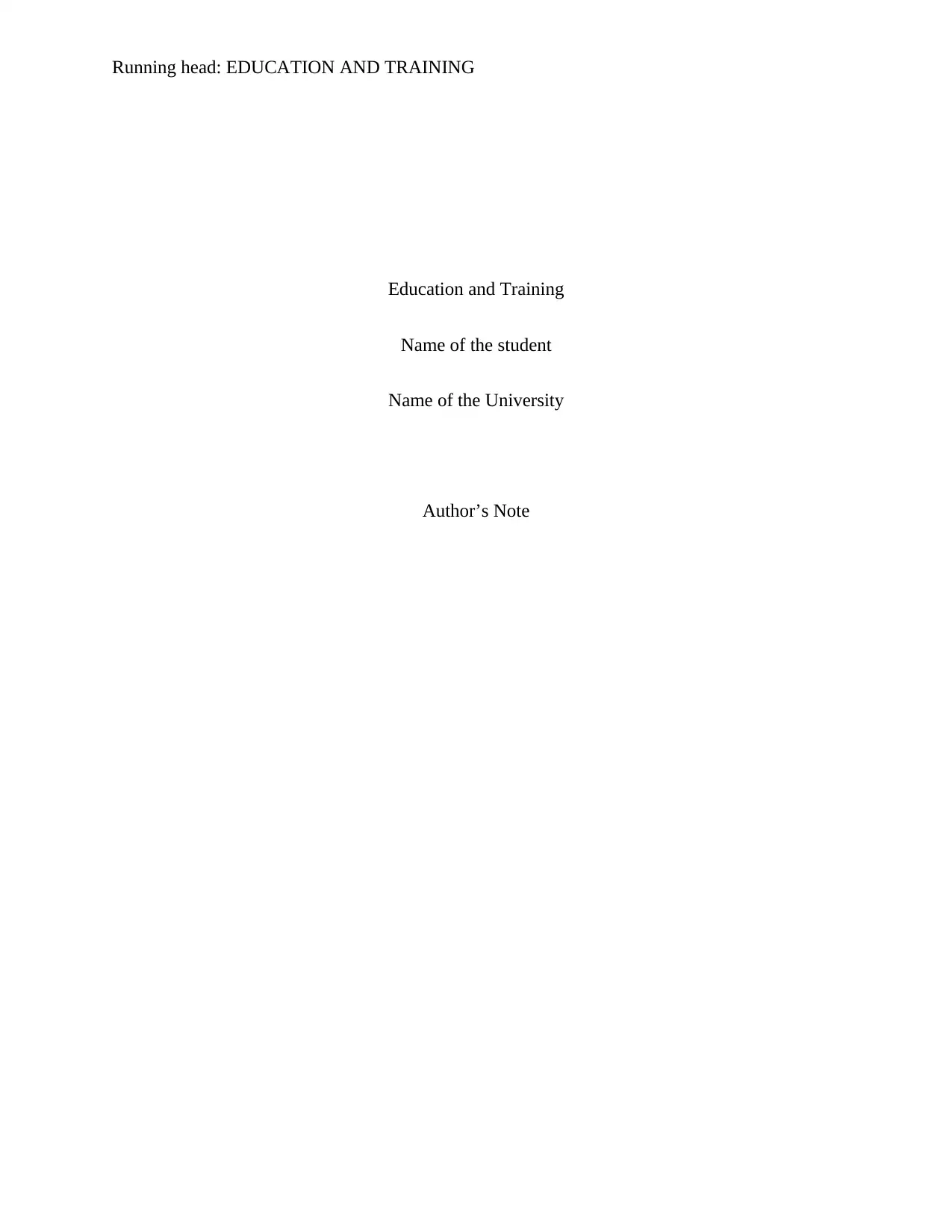
Running head: EDUCATION AND TRAINING
Education and Training
Name of the student
Name of the University
Author’s Note
Education and Training
Name of the student
Name of the University
Author’s Note
Paraphrase This Document
Need a fresh take? Get an instant paraphrase of this document with our AI Paraphraser
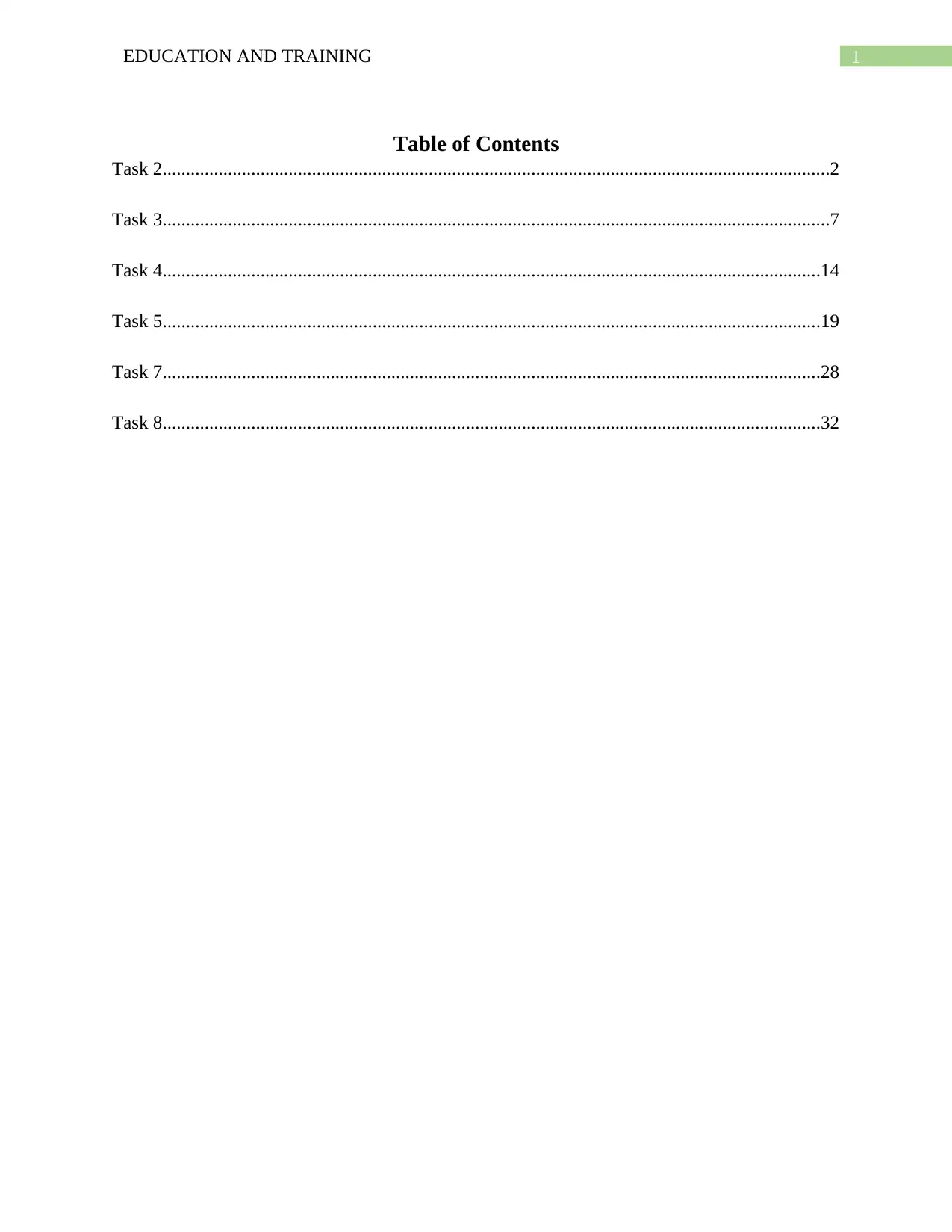
1EDUCATION AND TRAINING
Table of Contents
Task 2...............................................................................................................................................2
Task 3...............................................................................................................................................7
Task 4.............................................................................................................................................14
Task 5.............................................................................................................................................19
Task 7.............................................................................................................................................28
Task 8.............................................................................................................................................32
Table of Contents
Task 2...............................................................................................................................................2
Task 3...............................................................................................................................................7
Task 4.............................................................................................................................................14
Task 5.............................................................................................................................................19
Task 7.............................................................................................................................................28
Task 8.............................................................................................................................................32
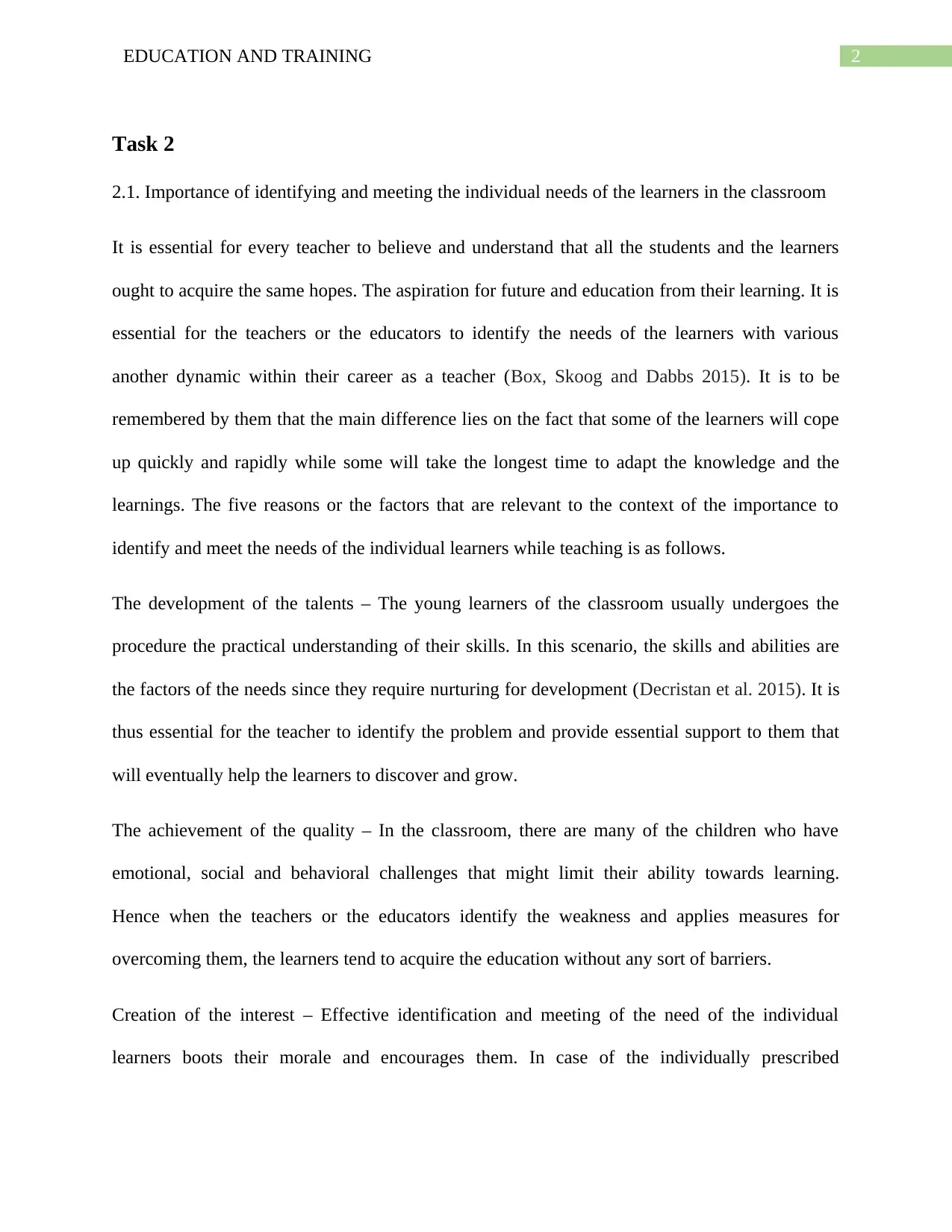
2EDUCATION AND TRAINING
Task 2
2.1. Importance of identifying and meeting the individual needs of the learners in the classroom
It is essential for every teacher to believe and understand that all the students and the learners
ought to acquire the same hopes. The aspiration for future and education from their learning. It is
essential for the teachers or the educators to identify the needs of the learners with various
another dynamic within their career as a teacher (Box, Skoog and Dabbs 2015). It is to be
remembered by them that the main difference lies on the fact that some of the learners will cope
up quickly and rapidly while some will take the longest time to adapt the knowledge and the
learnings. The five reasons or the factors that are relevant to the context of the importance to
identify and meet the needs of the individual learners while teaching is as follows.
The development of the talents – The young learners of the classroom usually undergoes the
procedure the practical understanding of their skills. In this scenario, the skills and abilities are
the factors of the needs since they require nurturing for development (Decristan et al. 2015). It is
thus essential for the teacher to identify the problem and provide essential support to them that
will eventually help the learners to discover and grow.
The achievement of the quality – In the classroom, there are many of the children who have
emotional, social and behavioral challenges that might limit their ability towards learning.
Hence when the teachers or the educators identify the weakness and applies measures for
overcoming them, the learners tend to acquire the education without any sort of barriers.
Creation of the interest – Effective identification and meeting of the need of the individual
learners boots their morale and encourages them. In case of the individually prescribed
Task 2
2.1. Importance of identifying and meeting the individual needs of the learners in the classroom
It is essential for every teacher to believe and understand that all the students and the learners
ought to acquire the same hopes. The aspiration for future and education from their learning. It is
essential for the teachers or the educators to identify the needs of the learners with various
another dynamic within their career as a teacher (Box, Skoog and Dabbs 2015). It is to be
remembered by them that the main difference lies on the fact that some of the learners will cope
up quickly and rapidly while some will take the longest time to adapt the knowledge and the
learnings. The five reasons or the factors that are relevant to the context of the importance to
identify and meet the needs of the individual learners while teaching is as follows.
The development of the talents – The young learners of the classroom usually undergoes the
procedure the practical understanding of their skills. In this scenario, the skills and abilities are
the factors of the needs since they require nurturing for development (Decristan et al. 2015). It is
thus essential for the teacher to identify the problem and provide essential support to them that
will eventually help the learners to discover and grow.
The achievement of the quality – In the classroom, there are many of the children who have
emotional, social and behavioral challenges that might limit their ability towards learning.
Hence when the teachers or the educators identify the weakness and applies measures for
overcoming them, the learners tend to acquire the education without any sort of barriers.
Creation of the interest – Effective identification and meeting of the need of the individual
learners boots their morale and encourages them. In case of the individually prescribed
⊘ This is a preview!⊘
Do you want full access?
Subscribe today to unlock all pages.

Trusted by 1+ million students worldwide
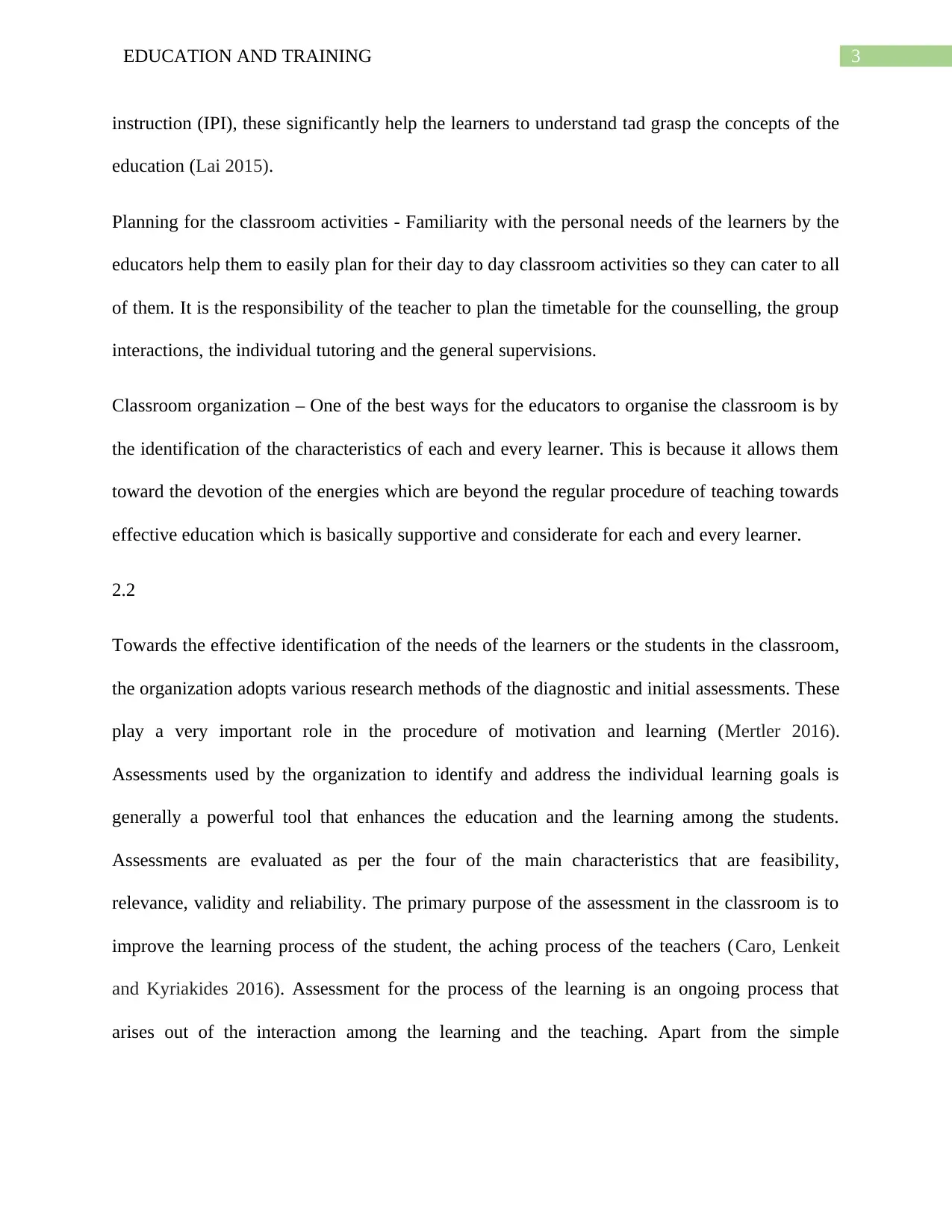
3EDUCATION AND TRAINING
instruction (IPI), these significantly help the learners to understand tad grasp the concepts of the
education (Lai 2015).
Planning for the classroom activities - Familiarity with the personal needs of the learners by the
educators help them to easily plan for their day to day classroom activities so they can cater to all
of them. It is the responsibility of the teacher to plan the timetable for the counselling, the group
interactions, the individual tutoring and the general supervisions.
Classroom organization – One of the best ways for the educators to organise the classroom is by
the identification of the characteristics of each and every learner. This is because it allows them
toward the devotion of the energies which are beyond the regular procedure of teaching towards
effective education which is basically supportive and considerate for each and every learner.
2.2
Towards the effective identification of the needs of the learners or the students in the classroom,
the organization adopts various research methods of the diagnostic and initial assessments. These
play a very important role in the procedure of motivation and learning (Mertler 2016).
Assessments used by the organization to identify and address the individual learning goals is
generally a powerful tool that enhances the education and the learning among the students.
Assessments are evaluated as per the four of the main characteristics that are feasibility,
relevance, validity and reliability. The primary purpose of the assessment in the classroom is to
improve the learning process of the student, the aching process of the teachers (Caro, Lenkeit
and Kyriakides 2016). Assessment for the process of the learning is an ongoing process that
arises out of the interaction among the learning and the teaching. Apart from the simple
instruction (IPI), these significantly help the learners to understand tad grasp the concepts of the
education (Lai 2015).
Planning for the classroom activities - Familiarity with the personal needs of the learners by the
educators help them to easily plan for their day to day classroom activities so they can cater to all
of them. It is the responsibility of the teacher to plan the timetable for the counselling, the group
interactions, the individual tutoring and the general supervisions.
Classroom organization – One of the best ways for the educators to organise the classroom is by
the identification of the characteristics of each and every learner. This is because it allows them
toward the devotion of the energies which are beyond the regular procedure of teaching towards
effective education which is basically supportive and considerate for each and every learner.
2.2
Towards the effective identification of the needs of the learners or the students in the classroom,
the organization adopts various research methods of the diagnostic and initial assessments. These
play a very important role in the procedure of motivation and learning (Mertler 2016).
Assessments used by the organization to identify and address the individual learning goals is
generally a powerful tool that enhances the education and the learning among the students.
Assessments are evaluated as per the four of the main characteristics that are feasibility,
relevance, validity and reliability. The primary purpose of the assessment in the classroom is to
improve the learning process of the student, the aching process of the teachers (Caro, Lenkeit
and Kyriakides 2016). Assessment for the process of the learning is an ongoing process that
arises out of the interaction among the learning and the teaching. Apart from the simple
Paraphrase This Document
Need a fresh take? Get an instant paraphrase of this document with our AI Paraphraser
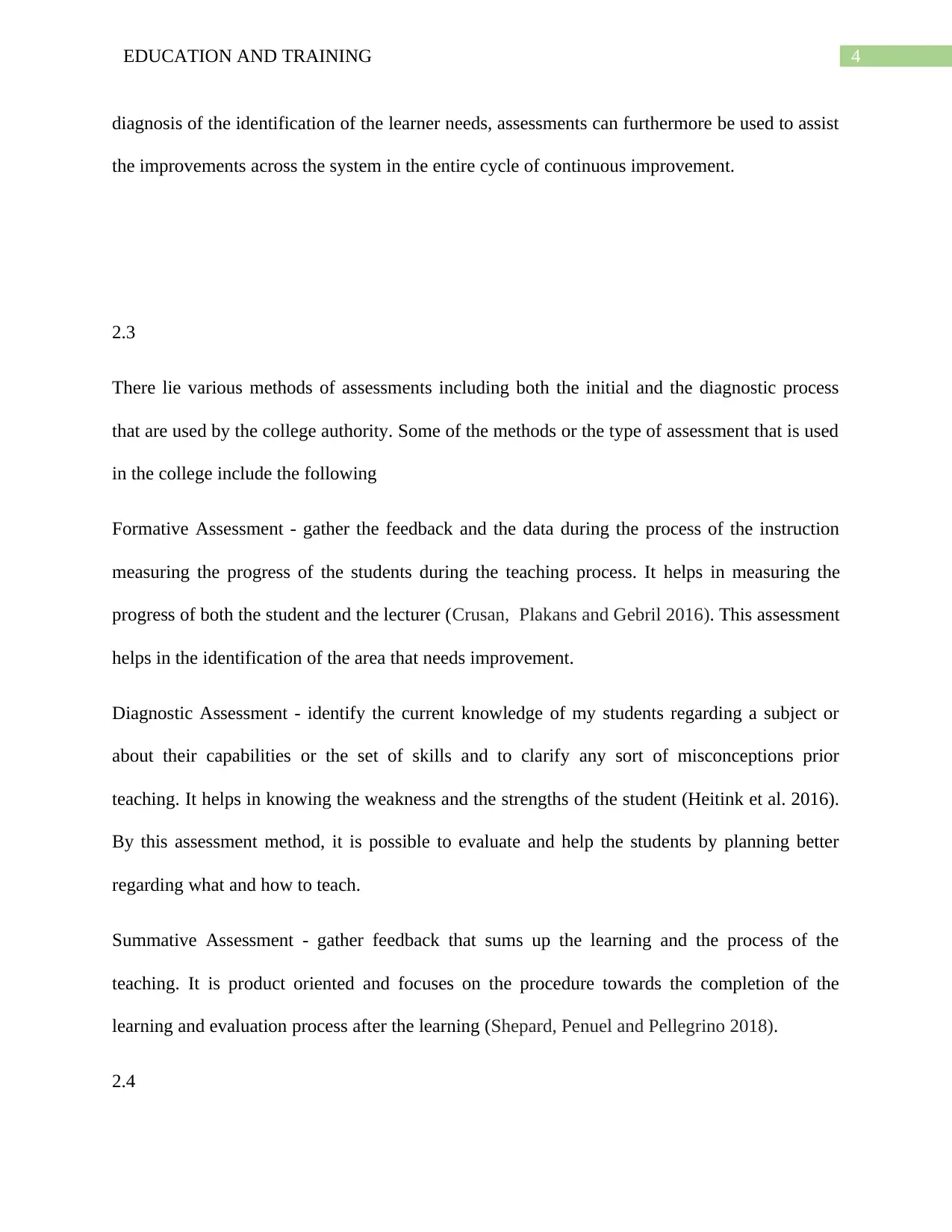
4EDUCATION AND TRAINING
diagnosis of the identification of the learner needs, assessments can furthermore be used to assist
the improvements across the system in the entire cycle of continuous improvement.
2.3
There lie various methods of assessments including both the initial and the diagnostic process
that are used by the college authority. Some of the methods or the type of assessment that is used
in the college include the following
Formative Assessment - gather the feedback and the data during the process of the instruction
measuring the progress of the students during the teaching process. It helps in measuring the
progress of both the student and the lecturer (Crusan, Plakans and Gebril 2016). This assessment
helps in the identification of the area that needs improvement.
Diagnostic Assessment - identify the current knowledge of my students regarding a subject or
about their capabilities or the set of skills and to clarify any sort of misconceptions prior
teaching. It helps in knowing the weakness and the strengths of the student (Heitink et al. 2016).
By this assessment method, it is possible to evaluate and help the students by planning better
regarding what and how to teach.
Summative Assessment - gather feedback that sums up the learning and the process of the
teaching. It is product oriented and focuses on the procedure towards the completion of the
learning and evaluation process after the learning (Shepard, Penuel and Pellegrino 2018).
2.4
diagnosis of the identification of the learner needs, assessments can furthermore be used to assist
the improvements across the system in the entire cycle of continuous improvement.
2.3
There lie various methods of assessments including both the initial and the diagnostic process
that are used by the college authority. Some of the methods or the type of assessment that is used
in the college include the following
Formative Assessment - gather the feedback and the data during the process of the instruction
measuring the progress of the students during the teaching process. It helps in measuring the
progress of both the student and the lecturer (Crusan, Plakans and Gebril 2016). This assessment
helps in the identification of the area that needs improvement.
Diagnostic Assessment - identify the current knowledge of my students regarding a subject or
about their capabilities or the set of skills and to clarify any sort of misconceptions prior
teaching. It helps in knowing the weakness and the strengths of the student (Heitink et al. 2016).
By this assessment method, it is possible to evaluate and help the students by planning better
regarding what and how to teach.
Summative Assessment - gather feedback that sums up the learning and the process of the
teaching. It is product oriented and focuses on the procedure towards the completion of the
learning and evaluation process after the learning (Shepard, Penuel and Pellegrino 2018).
2.4
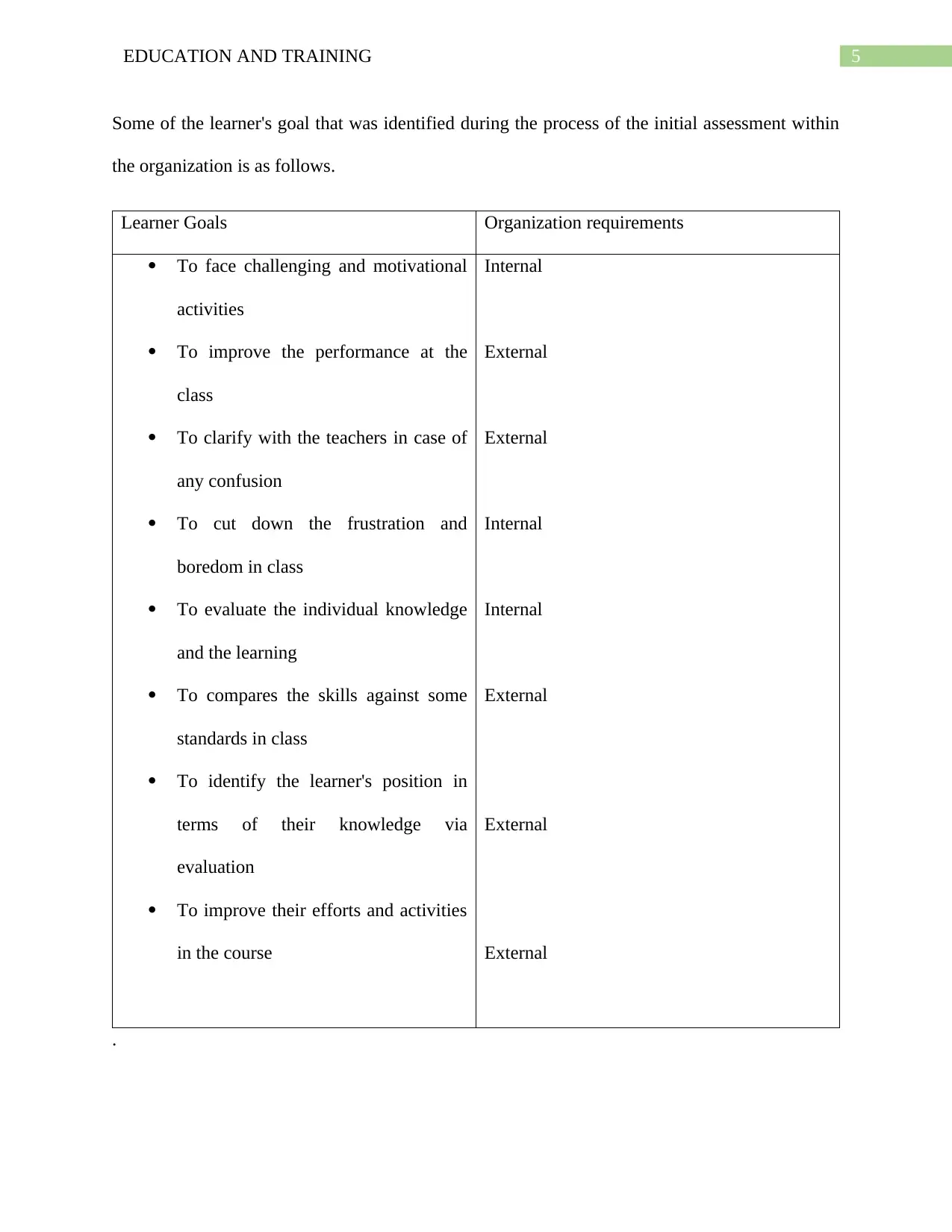
5EDUCATION AND TRAINING
Some of the learner's goal that was identified during the process of the initial assessment within
the organization is as follows.
Learner Goals Organization requirements
To face challenging and motivational
activities
To improve the performance at the
class
To clarify with the teachers in case of
any confusion
To cut down the frustration and
boredom in class
To evaluate the individual knowledge
and the learning
To compares the skills against some
standards in class
To identify the learner's position in
terms of their knowledge via
evaluation
To improve their efforts and activities
in the course
Internal
External
External
Internal
Internal
External
External
External
.
Some of the learner's goal that was identified during the process of the initial assessment within
the organization is as follows.
Learner Goals Organization requirements
To face challenging and motivational
activities
To improve the performance at the
class
To clarify with the teachers in case of
any confusion
To cut down the frustration and
boredom in class
To evaluate the individual knowledge
and the learning
To compares the skills against some
standards in class
To identify the learner's position in
terms of their knowledge via
evaluation
To improve their efforts and activities
in the course
Internal
External
External
Internal
Internal
External
External
External
.
⊘ This is a preview!⊘
Do you want full access?
Subscribe today to unlock all pages.

Trusted by 1+ million students worldwide
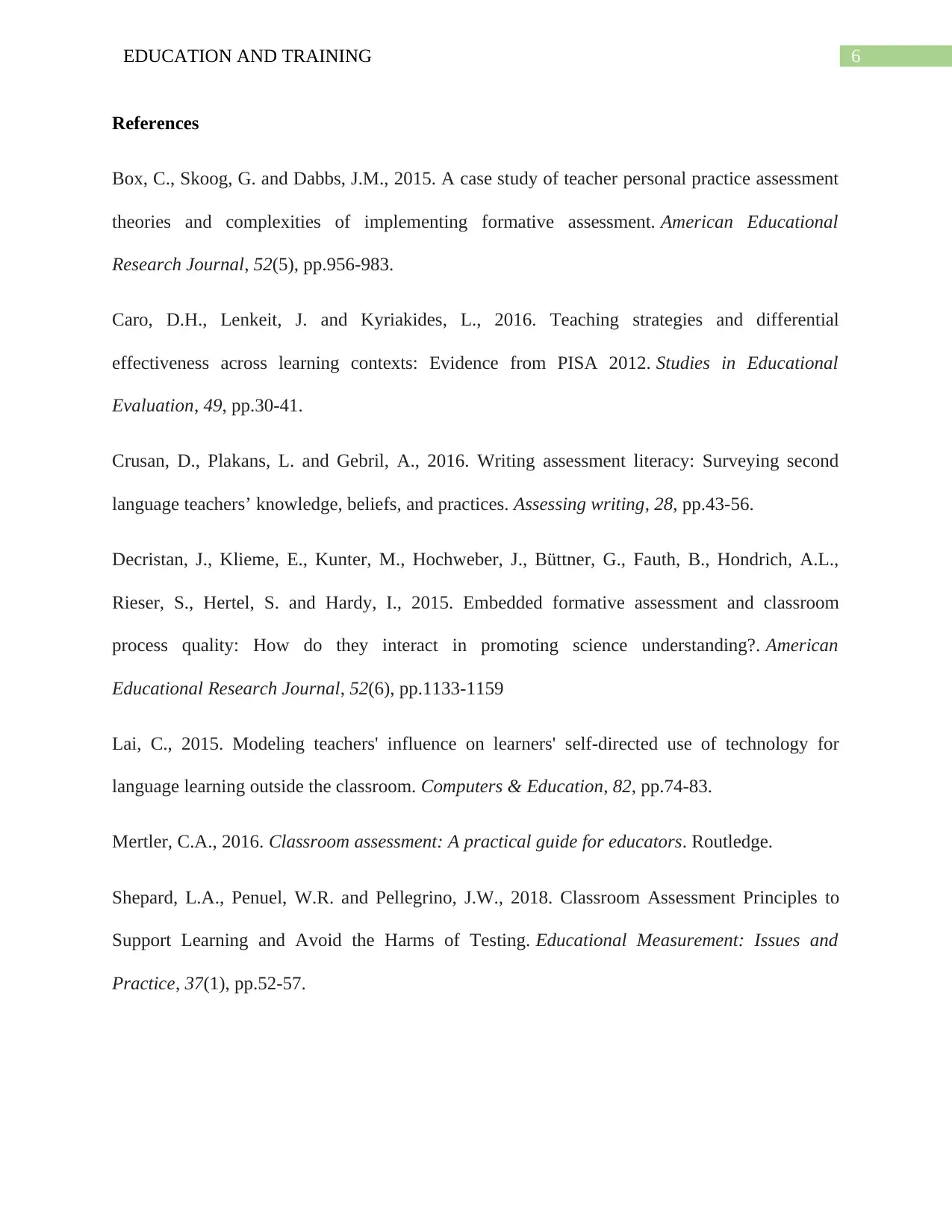
6EDUCATION AND TRAINING
References
Box, C., Skoog, G. and Dabbs, J.M., 2015. A case study of teacher personal practice assessment
theories and complexities of implementing formative assessment. American Educational
Research Journal, 52(5), pp.956-983.
Caro, D.H., Lenkeit, J. and Kyriakides, L., 2016. Teaching strategies and differential
effectiveness across learning contexts: Evidence from PISA 2012. Studies in Educational
Evaluation, 49, pp.30-41.
Crusan, D., Plakans, L. and Gebril, A., 2016. Writing assessment literacy: Surveying second
language teachers’ knowledge, beliefs, and practices. Assessing writing, 28, pp.43-56.
Decristan, J., Klieme, E., Kunter, M., Hochweber, J., Büttner, G., Fauth, B., Hondrich, A.L.,
Rieser, S., Hertel, S. and Hardy, I., 2015. Embedded formative assessment and classroom
process quality: How do they interact in promoting science understanding?. American
Educational Research Journal, 52(6), pp.1133-1159
Lai, C., 2015. Modeling teachers' influence on learners' self-directed use of technology for
language learning outside the classroom. Computers & Education, 82, pp.74-83.
Mertler, C.A., 2016. Classroom assessment: A practical guide for educators. Routledge.
Shepard, L.A., Penuel, W.R. and Pellegrino, J.W., 2018. Classroom Assessment Principles to
Support Learning and Avoid the Harms of Testing. Educational Measurement: Issues and
Practice, 37(1), pp.52-57.
References
Box, C., Skoog, G. and Dabbs, J.M., 2015. A case study of teacher personal practice assessment
theories and complexities of implementing formative assessment. American Educational
Research Journal, 52(5), pp.956-983.
Caro, D.H., Lenkeit, J. and Kyriakides, L., 2016. Teaching strategies and differential
effectiveness across learning contexts: Evidence from PISA 2012. Studies in Educational
Evaluation, 49, pp.30-41.
Crusan, D., Plakans, L. and Gebril, A., 2016. Writing assessment literacy: Surveying second
language teachers’ knowledge, beliefs, and practices. Assessing writing, 28, pp.43-56.
Decristan, J., Klieme, E., Kunter, M., Hochweber, J., Büttner, G., Fauth, B., Hondrich, A.L.,
Rieser, S., Hertel, S. and Hardy, I., 2015. Embedded formative assessment and classroom
process quality: How do they interact in promoting science understanding?. American
Educational Research Journal, 52(6), pp.1133-1159
Lai, C., 2015. Modeling teachers' influence on learners' self-directed use of technology for
language learning outside the classroom. Computers & Education, 82, pp.74-83.
Mertler, C.A., 2016. Classroom assessment: A practical guide for educators. Routledge.
Shepard, L.A., Penuel, W.R. and Pellegrino, J.W., 2018. Classroom Assessment Principles to
Support Learning and Avoid the Harms of Testing. Educational Measurement: Issues and
Practice, 37(1), pp.52-57.
Paraphrase This Document
Need a fresh take? Get an instant paraphrase of this document with our AI Paraphraser
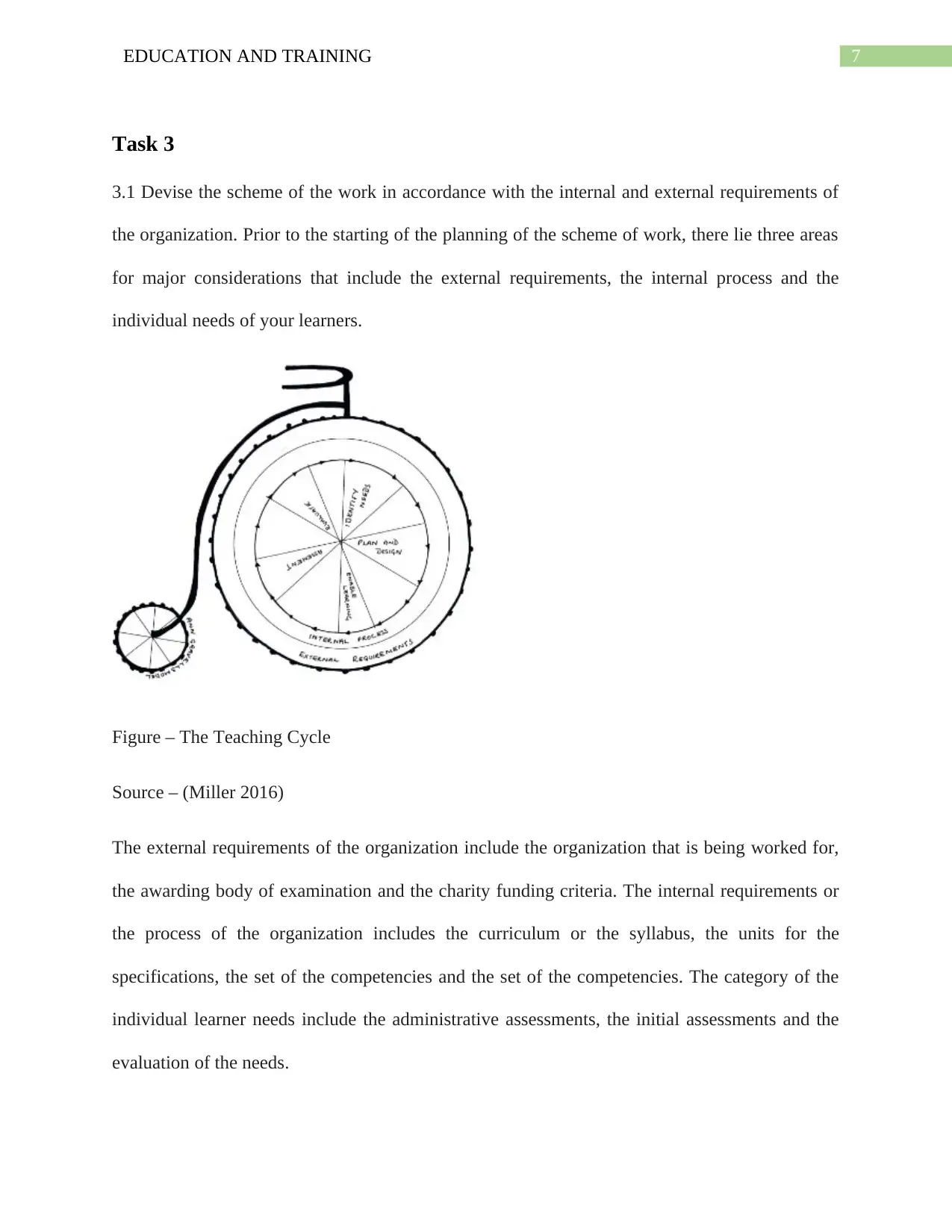
7EDUCATION AND TRAINING
Task 3
3.1 Devise the scheme of the work in accordance with the internal and external requirements of
the organization. Prior to the starting of the planning of the scheme of work, there lie three areas
for major considerations that include the external requirements, the internal process and the
individual needs of your learners.
Figure – The Teaching Cycle
Source – (Miller 2016)
The external requirements of the organization include the organization that is being worked for,
the awarding body of examination and the charity funding criteria. The internal requirements or
the process of the organization includes the curriculum or the syllabus, the units for the
specifications, the set of the competencies and the set of the competencies. The category of the
individual learner needs include the administrative assessments, the initial assessments and the
evaluation of the needs.
Task 3
3.1 Devise the scheme of the work in accordance with the internal and external requirements of
the organization. Prior to the starting of the planning of the scheme of work, there lie three areas
for major considerations that include the external requirements, the internal process and the
individual needs of your learners.
Figure – The Teaching Cycle
Source – (Miller 2016)
The external requirements of the organization include the organization that is being worked for,
the awarding body of examination and the charity funding criteria. The internal requirements or
the process of the organization includes the curriculum or the syllabus, the units for the
specifications, the set of the competencies and the set of the competencies. The category of the
individual learner needs include the administrative assessments, the initial assessments and the
evaluation of the needs.
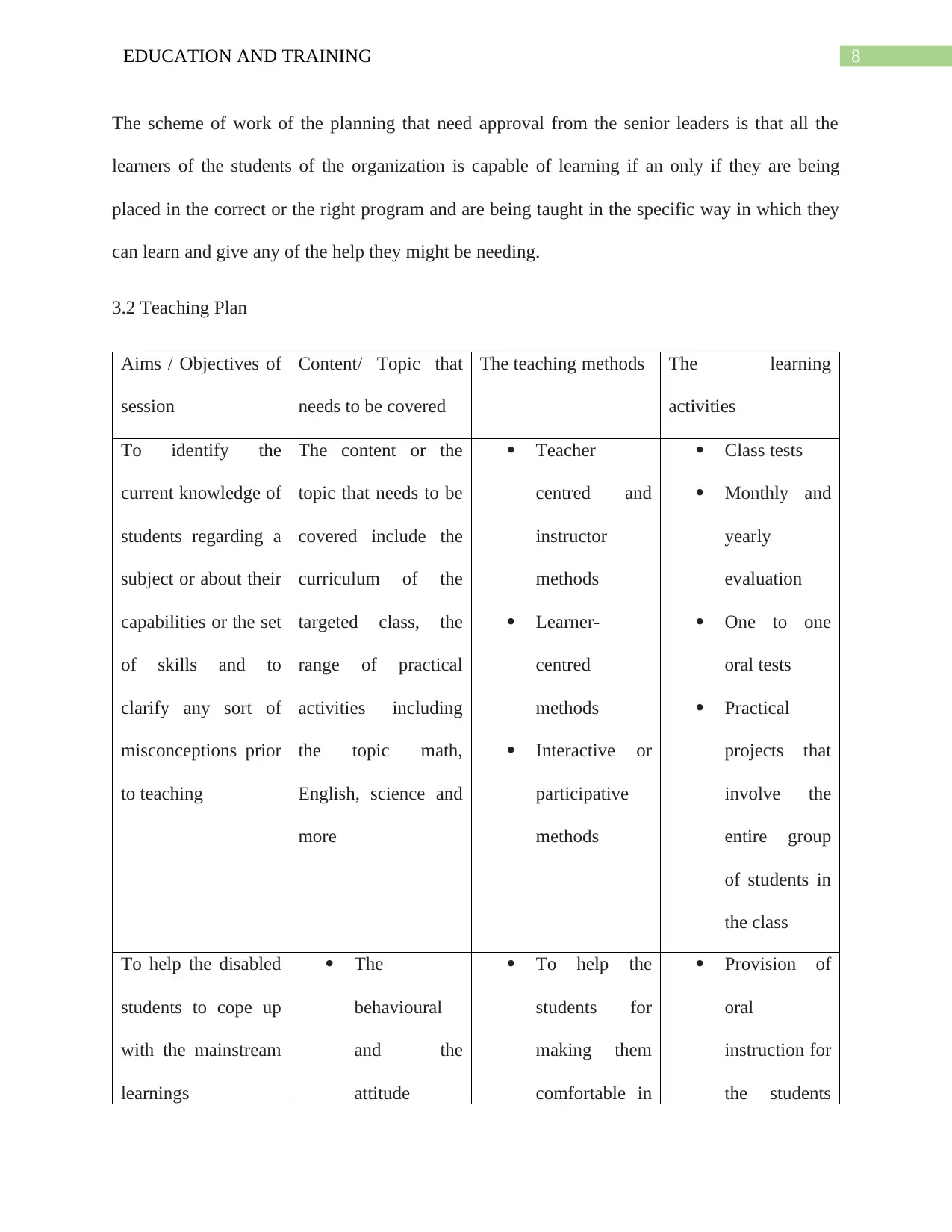
8EDUCATION AND TRAINING
The scheme of work of the planning that need approval from the senior leaders is that all the
learners of the students of the organization is capable of learning if an only if they are being
placed in the correct or the right program and are being taught in the specific way in which they
can learn and give any of the help they might be needing.
3.2 Teaching Plan
Aims / Objectives of
session
Content/ Topic that
needs to be covered
The teaching methods The learning
activities
To identify the
current knowledge of
students regarding a
subject or about their
capabilities or the set
of skills and to
clarify any sort of
misconceptions prior
to teaching
The content or the
topic that needs to be
covered include the
curriculum of the
targeted class, the
range of practical
activities including
the topic math,
English, science and
more
Teacher
centred and
instructor
methods
Learner-
centred
methods
Interactive or
participative
methods
Class tests
Monthly and
yearly
evaluation
One to one
oral tests
Practical
projects that
involve the
entire group
of students in
the class
To help the disabled
students to cope up
with the mainstream
learnings
The
behavioural
and the
attitude
To help the
students for
making them
comfortable in
Provision of
oral
instruction for
the students
The scheme of work of the planning that need approval from the senior leaders is that all the
learners of the students of the organization is capable of learning if an only if they are being
placed in the correct or the right program and are being taught in the specific way in which they
can learn and give any of the help they might be needing.
3.2 Teaching Plan
Aims / Objectives of
session
Content/ Topic that
needs to be covered
The teaching methods The learning
activities
To identify the
current knowledge of
students regarding a
subject or about their
capabilities or the set
of skills and to
clarify any sort of
misconceptions prior
to teaching
The content or the
topic that needs to be
covered include the
curriculum of the
targeted class, the
range of practical
activities including
the topic math,
English, science and
more
Teacher
centred and
instructor
methods
Learner-
centred
methods
Interactive or
participative
methods
Class tests
Monthly and
yearly
evaluation
One to one
oral tests
Practical
projects that
involve the
entire group
of students in
the class
To help the disabled
students to cope up
with the mainstream
learnings
The
behavioural
and the
attitude
To help the
students for
making them
comfortable in
Provision of
oral
instruction for
the students
⊘ This is a preview!⊘
Do you want full access?
Subscribe today to unlock all pages.

Trusted by 1+ million students worldwide
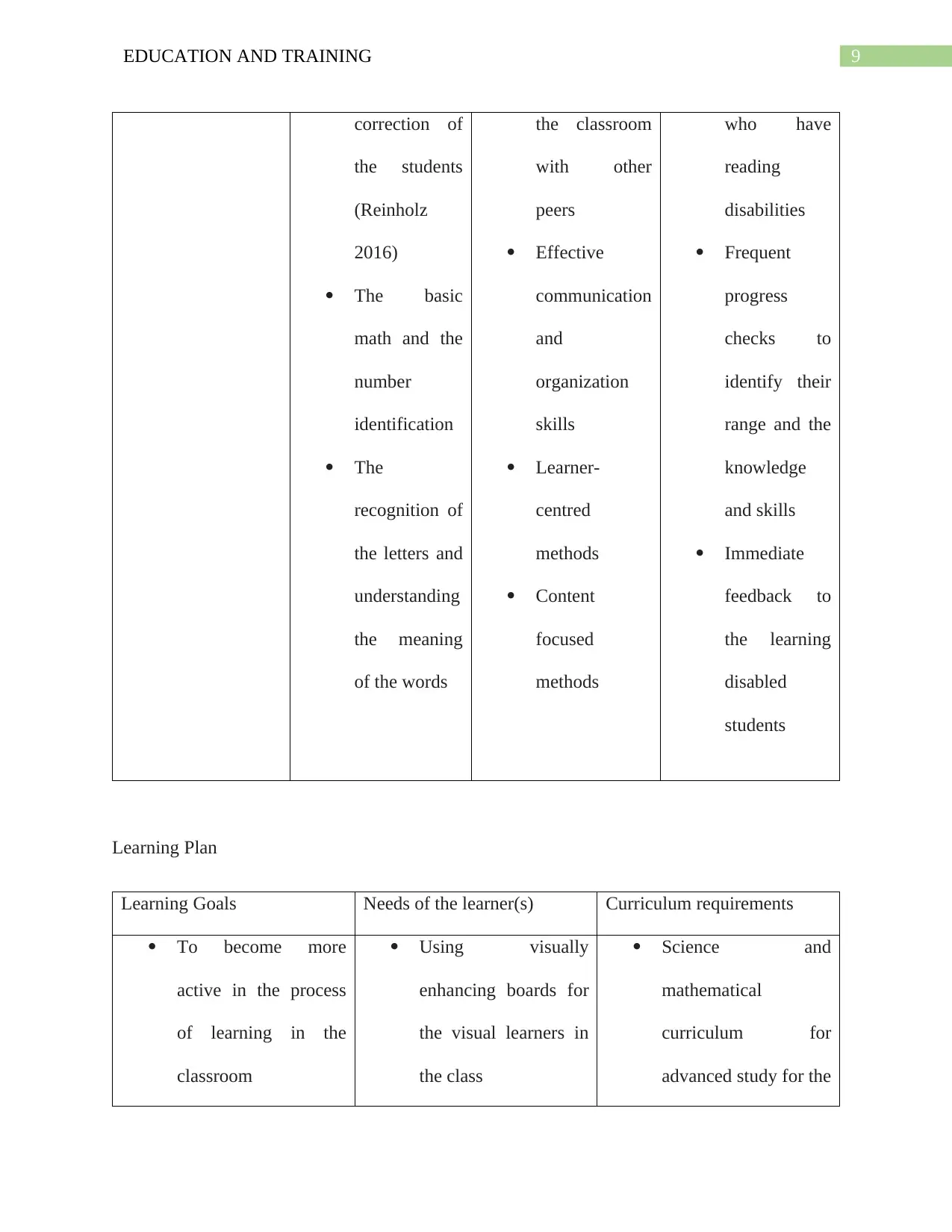
9EDUCATION AND TRAINING
correction of
the students
(Reinholz
2016)
The basic
math and the
number
identification
The
recognition of
the letters and
understanding
the meaning
of the words
the classroom
with other
peers
Effective
communication
and
organization
skills
Learner-
centred
methods
Content
focused
methods
who have
reading
disabilities
Frequent
progress
checks to
identify their
range and the
knowledge
and skills
Immediate
feedback to
the learning
disabled
students
Learning Plan
Learning Goals Needs of the learner(s) Curriculum requirements
To become more
active in the process
of learning in the
classroom
Using visually
enhancing boards for
the visual learners in
the class
Science and
mathematical
curriculum for
advanced study for the
correction of
the students
(Reinholz
2016)
The basic
math and the
number
identification
The
recognition of
the letters and
understanding
the meaning
of the words
the classroom
with other
peers
Effective
communication
and
organization
skills
Learner-
centred
methods
Content
focused
methods
who have
reading
disabilities
Frequent
progress
checks to
identify their
range and the
knowledge
and skills
Immediate
feedback to
the learning
disabled
students
Learning Plan
Learning Goals Needs of the learner(s) Curriculum requirements
To become more
active in the process
of learning in the
classroom
Using visually
enhancing boards for
the visual learners in
the class
Science and
mathematical
curriculum for
advanced study for the
Paraphrase This Document
Need a fresh take? Get an instant paraphrase of this document with our AI Paraphraser
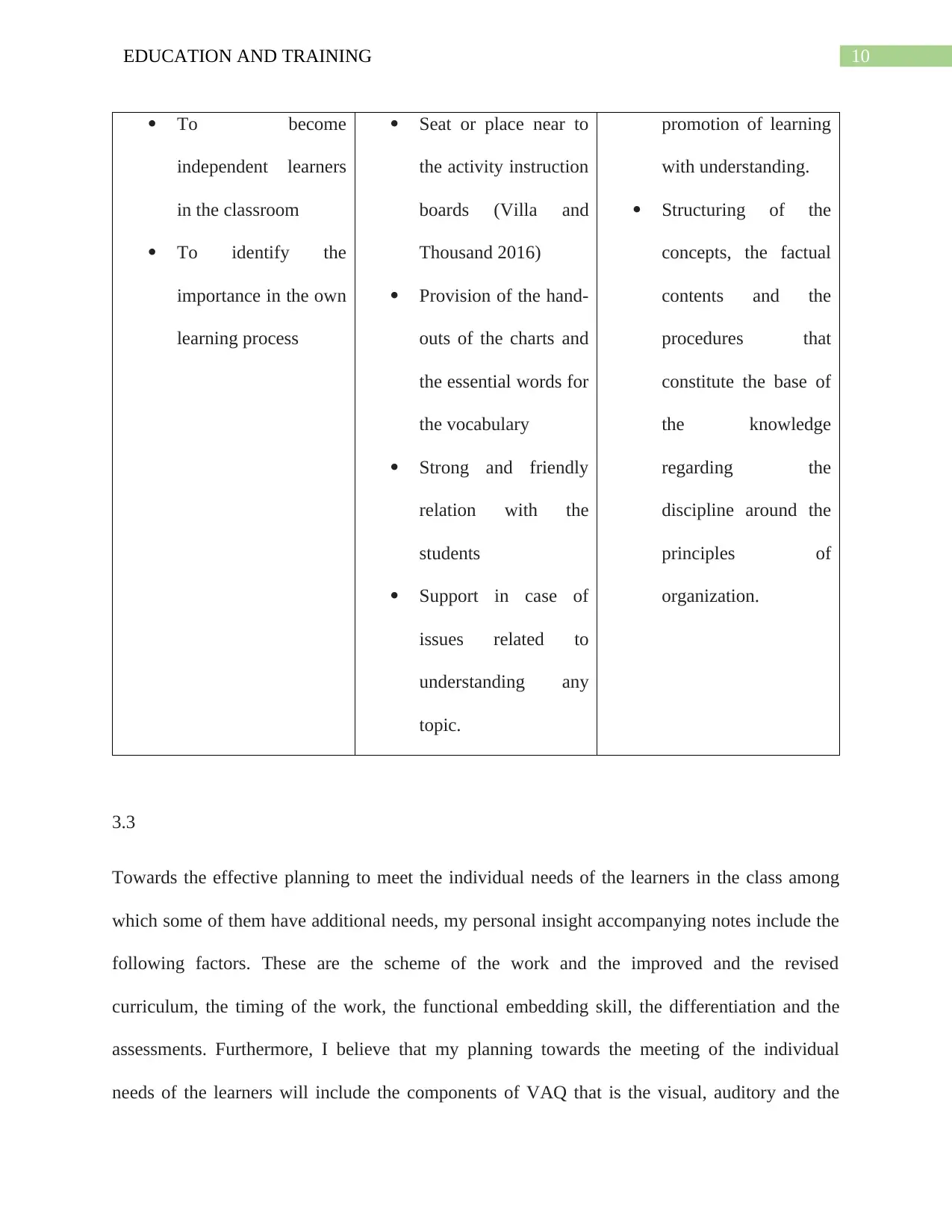
10EDUCATION AND TRAINING
To become
independent learners
in the classroom
To identify the
importance in the own
learning process
Seat or place near to
the activity instruction
boards (Villa and
Thousand 2016)
Provision of the hand-
outs of the charts and
the essential words for
the vocabulary
Strong and friendly
relation with the
students
Support in case of
issues related to
understanding any
topic.
promotion of learning
with understanding.
Structuring of the
concepts, the factual
contents and the
procedures that
constitute the base of
the knowledge
regarding the
discipline around the
principles of
organization.
3.3
Towards the effective planning to meet the individual needs of the learners in the class among
which some of them have additional needs, my personal insight accompanying notes include the
following factors. These are the scheme of the work and the improved and the revised
curriculum, the timing of the work, the functional embedding skill, the differentiation and the
assessments. Furthermore, I believe that my planning towards the meeting of the individual
needs of the learners will include the components of VAQ that is the visual, auditory and the
To become
independent learners
in the classroom
To identify the
importance in the own
learning process
Seat or place near to
the activity instruction
boards (Villa and
Thousand 2016)
Provision of the hand-
outs of the charts and
the essential words for
the vocabulary
Strong and friendly
relation with the
students
Support in case of
issues related to
understanding any
topic.
promotion of learning
with understanding.
Structuring of the
concepts, the factual
contents and the
procedures that
constitute the base of
the knowledge
regarding the
discipline around the
principles of
organization.
3.3
Towards the effective planning to meet the individual needs of the learners in the class among
which some of them have additional needs, my personal insight accompanying notes include the
following factors. These are the scheme of the work and the improved and the revised
curriculum, the timing of the work, the functional embedding skill, the differentiation and the
assessments. Furthermore, I believe that my planning towards the meeting of the individual
needs of the learners will include the components of VAQ that is the visual, auditory and the
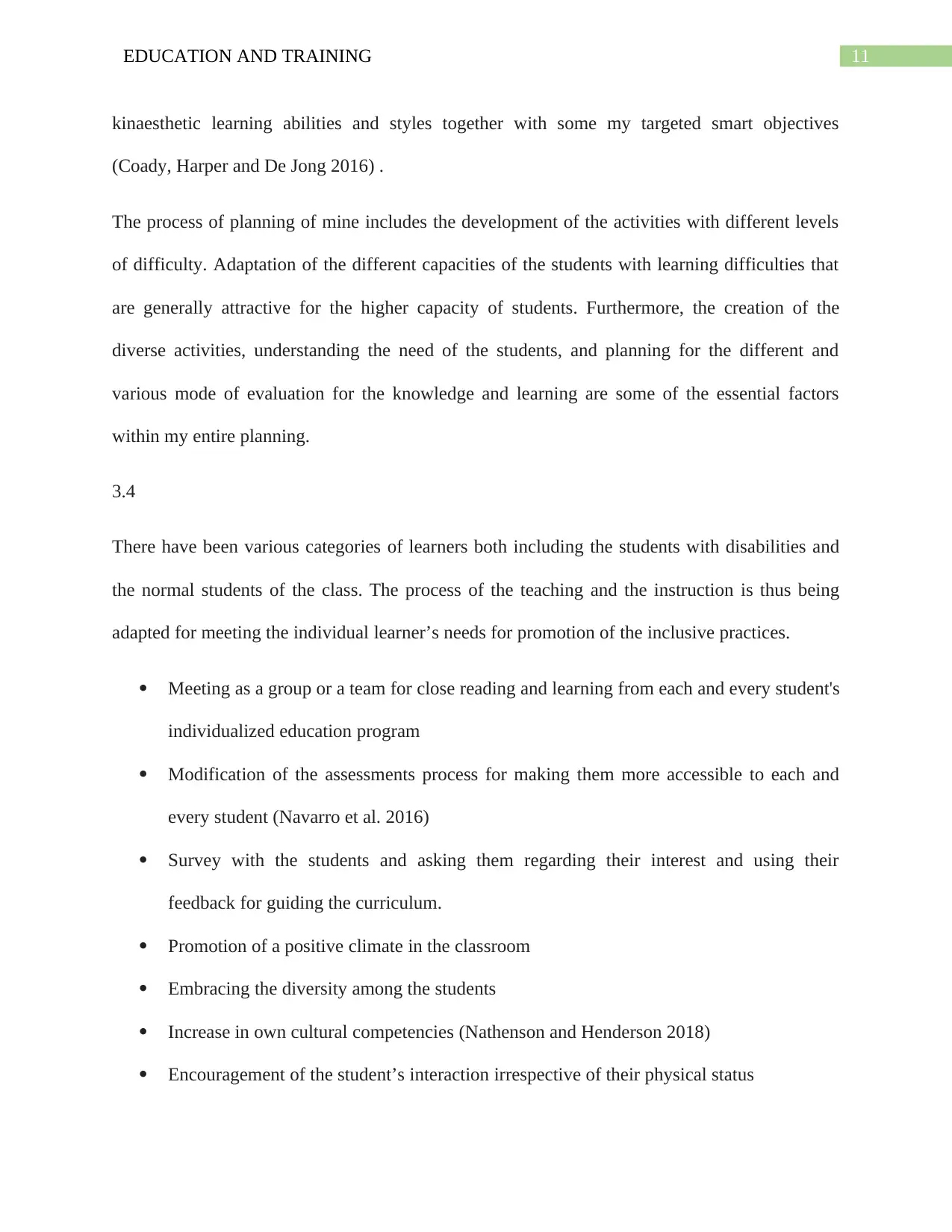
11EDUCATION AND TRAINING
kinaesthetic learning abilities and styles together with some my targeted smart objectives
(Coady, Harper and De Jong 2016) .
The process of planning of mine includes the development of the activities with different levels
of difficulty. Adaptation of the different capacities of the students with learning difficulties that
are generally attractive for the higher capacity of students. Furthermore, the creation of the
diverse activities, understanding the need of the students, and planning for the different and
various mode of evaluation for the knowledge and learning are some of the essential factors
within my entire planning.
3.4
There have been various categories of learners both including the students with disabilities and
the normal students of the class. The process of the teaching and the instruction is thus being
adapted for meeting the individual learner’s needs for promotion of the inclusive practices.
Meeting as a group or a team for close reading and learning from each and every student's
individualized education program
Modification of the assessments process for making them more accessible to each and
every student (Navarro et al. 2016)
Survey with the students and asking them regarding their interest and using their
feedback for guiding the curriculum.
Promotion of a positive climate in the classroom
Embracing the diversity among the students
Increase in own cultural competencies (Nathenson and Henderson 2018)
Encouragement of the student’s interaction irrespective of their physical status
kinaesthetic learning abilities and styles together with some my targeted smart objectives
(Coady, Harper and De Jong 2016) .
The process of planning of mine includes the development of the activities with different levels
of difficulty. Adaptation of the different capacities of the students with learning difficulties that
are generally attractive for the higher capacity of students. Furthermore, the creation of the
diverse activities, understanding the need of the students, and planning for the different and
various mode of evaluation for the knowledge and learning are some of the essential factors
within my entire planning.
3.4
There have been various categories of learners both including the students with disabilities and
the normal students of the class. The process of the teaching and the instruction is thus being
adapted for meeting the individual learner’s needs for promotion of the inclusive practices.
Meeting as a group or a team for close reading and learning from each and every student's
individualized education program
Modification of the assessments process for making them more accessible to each and
every student (Navarro et al. 2016)
Survey with the students and asking them regarding their interest and using their
feedback for guiding the curriculum.
Promotion of a positive climate in the classroom
Embracing the diversity among the students
Increase in own cultural competencies (Nathenson and Henderson 2018)
Encouragement of the student’s interaction irrespective of their physical status
⊘ This is a preview!⊘
Do you want full access?
Subscribe today to unlock all pages.

Trusted by 1+ million students worldwide
1 out of 34
Related Documents
Your All-in-One AI-Powered Toolkit for Academic Success.
+13062052269
info@desklib.com
Available 24*7 on WhatsApp / Email
![[object Object]](/_next/static/media/star-bottom.7253800d.svg)
Unlock your academic potential
Copyright © 2020–2025 A2Z Services. All Rights Reserved. Developed and managed by ZUCOL.





